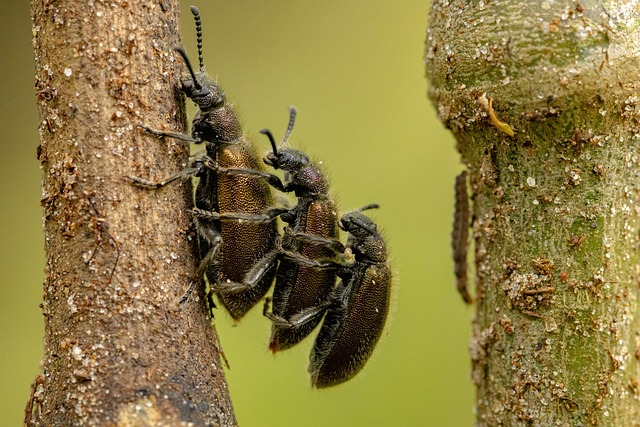Foreign grain beetles, common in warm, dry environments, are destructive pests infesting stored food products. Their life cycle involves egg, larva, pupa, and adult stages, with larvae creating tunnels in starch-rich materials. Early indicators of infestation include unique patterns of damage. Professional grain beetle extermination requires sanitation, physical exclusion, and targeted treatments to disrupt their breeding cycle and protect food stores. Advanced strategies like insect growth regulators (IGRs) and heat treatment are employed for effective foreign grain beetles removal in residential and commercial settings, offering durable solutions through integrated pest management (IPM). Long-term prevention involves excellent hygiene standards, sealing entry points, and regular inspections, providing both short-term solutions and lasting protection against these tiny invaders.
In the realm of food preservation, protecting stored grains from insect invaders is a constant battle. Foreign grain beetles, with their insidious nature and rapid reproduction, pose a significant threat to industries and households alike. This article explores innovative techniques for combating these pests, delving into understanding their behavior, professional extermination methods, treatment options for homes and businesses, and long-term prevention strategies. By adopting these effective beetle control solutions, we can safeguard our food supplies from these pesky intruders.
Understanding Foreign Grain Beetles: Behavior and Life Cycle
Foreign grain beetles are a common yet destructive pest that can infest stored food products in both residential and commercial settings. Understanding their behavior and life cycle is crucial for effective pest control for foreign grain beetles. These beetles, often referred to as flour beetles or weevils, thrive in warm, dry environments and are attracted to starchy materials like grains, pasta, and dried goods. They can quickly breed and multiply, causing significant damage to food items.
The life cycle of these insects involves several stages: egg, larva, pupa, and adult. Female beetles lay their eggs within the host material or nearby, and once hatched, larvae begin burrowing and feeding on the starch-rich interior. They create intricate tunnels and galleries, which can go undetected until the infestation is severe. Professional grain beetle extermination methods often involve identifying these unique patterns of damage as an early indicator of an ongoing problem. Effective foreign grain beetle removal requires a combination of sanitation, physical exclusion, and targeted treatments to disrupt their breeding cycle and protect valuable food stores.
Professional Grain Beetle Extermination Methods
Professionals employ sophisticated methods to eradicate foreign grain beetles and ensure effective pest control. One common approach is the use of insect growth regulators (IGRs), which disrupt the beetle’s life cycle by mimicking their natural hormones, preventing their development and reproduction. IGRs are often combined with targeted treatments, such as dusting or spraying with approved insecticides, to reach all inaccessible areas where beetles may hide. This strategy ensures a thorough and sustainable solution for both residential and commercial grain beetle treatment.
For severe infestations, heat treatment is another specialized technique used by professionals. This method involves heating the infested area to temperatures that are lethal to the beetles, while ensuring the safety of stored goods by controlling the temperature precisely. Commercial grain beetle removal often requires a multi-step strategy, including proper storage practices, sanitation, and integrated pest management (IPM) techniques to prevent reinfestation. These professional grain beetle extermination methods offer effective long-term solutions for foreign grain beetle pest control.
Residential and Commercial Grain Beetle Treatment Options
When dealing with foreign grain beetle infestations, both residential and commercial properties require specialized pest control measures. Homeowners often face challenges in identifying and eliminating these tiny invaders, which can quickly multiply and cause significant damage to stored grains and other food products. Professional grain beetle extermination services offer effective solutions for residential areas. These experts employ advanced techniques such as targeted treatments, sealing entry points, and implementing preventive measures to ensure a robust defense against grain beetles.
For commercial settings, like warehouses and agricultural facilities, comprehensive grain beetle control is paramount. Commercial grain beetle removal strategies involve intensive inspections, thorough cleaning protocols, and the application of eco-friendly insecticides. These professional pest control methods aim to eradicate existing infestations while implementing long-lasting solutions to prevent future foreign grain beetle intrusions. By combining these treatments with regular monitoring, businesses can maintain a clean and secure environment for their stored goods, safeguarding them from costly damage and ensuring consumer satisfaction.
Long-term Prevention Strategies for Effective Beetle Control Solutions
Implementing long-term prevention strategies is key to effectively managing and controlling foreign grain beetle infestations. Professional exterminators often recommend a multi-faceted approach, combining various techniques for optimal results. One crucial method involves maintaining excellent hygiene standards in storage areas. Regular cleaning, including sweeping, mopping, and eliminating any food debris or crumbs, creates an unappealing environment for these pests. Additionally, ensuring proper ventilation reduces moisture levels, as beetles are attracted to humid conditions.
Another effective strategy is to seal all potential entry points into storage facilities. This includes fixing cracks, gaps, or holes in walls, floors, and ceilings. Using airtight containers for food storage further restricts beetle access, making it harder for them to infest stored goods. In commercial settings, regular inspections and maintenance are vital, while residential properties can benefit from similar practices, especially after major renovations or construction projects. These measures collectively form a robust defense against foreign grain beetles, offering both short-term solutions and long-lasting protection.
In light of the above discussions on understanding and combating foreign grain beetles, it’s clear that a multi-faceted approach combining professional extermination methods, suitable residential and commercial treatments, and long-term prevention strategies is key to effective beetle control. By integrating these innovative techniques, individuals and businesses can safeguard their stored food from beetle infestations, ensuring a safer and more secure environment for their products. Remember that proactive measures are essential in the battle against these persistent pests, making these solutions a game-changer in the world of grain beetle pest control.
